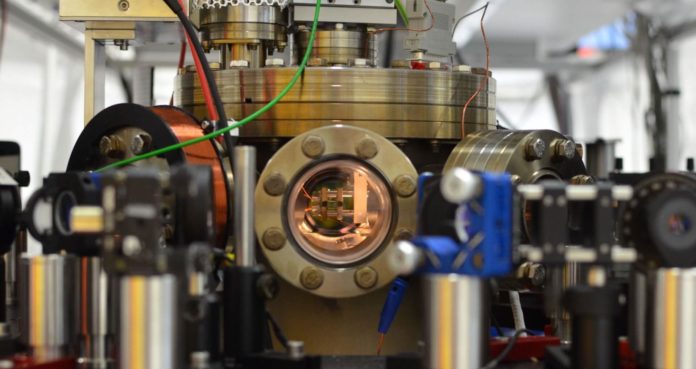Physicists have built the smallest working engine ever created. It’s a heat-powered motor barely larger than the single atom it runs on.
Designed and build by a team of experimental physicists led by Johannes Roßnagel (pronounced ‘Rossnahgel’) at the University of Mainz in Germany, the single atom engine is about as efficient as your car at transforming the changing temperature into mechanical energy.
“THE ENGINE HAS THE SAME WORKING PRINCIPLES AS THE WELL-KNOWN [COMBUSTION] CAR ENGINE”
While scientists have previously created several micro-engines consisting of a mere 10,000 particles, Roßnagel’s new engine blows these out of the water by paring down the machine to a singular atom housed in a nano-sized cone of electromagnetic radiation.
“The engine has the same working principles as the well-known [combustion] car engine,” Roßnagel says. It follows the same four strokes; expanding then cooling, contracting then heating.
Inside the engine
Roßnagel proposed the theoretical design of his one-atom engine in a scientific paper back in 2014. Now that he’s finally built the thing, it works almost exactly as he said it would.
First, the team traps a single atom in a cone of electromagnetic energy from which the atom cannot escape. You can think of this cone as essentially a tightly-fit engine housing. For this experiment the researchers trapped a lonely calcium-40 atom, but this is an arbitrary detail as pretty much any atom would do.
Roßnagel’s team then points two lasers toward each end of the cone. The laser pointing at the sharp end of the cone heats the atom, and the laser pointing at the base cools the atom via a process called Doppler cooling.

Source: Pixabay
This laser heating and cooling actually changes the size of the atom. Because the cone fits so snugly over the calcium atom, that temperature and size change forces the atom to scoot along the length of the cone. It moves toward the tapered point when cool and contracted, and toward the larger bottom when warm and expanded.
To boost the efficiency, Roßnagel’s team set their lasers to cool and heat their calcium atom at the same resonance at which the atom naturally vibrates back and fourth.
This hot and cold oscillation between the two ends of the cone builds up, like a growing sound wave, creating energy that Roßnagel measured (and could theoretically harness). As he explained to us back in 2014, “If you imagine that you put a second ion by the cooler side, it could absorb the mechanical energy of our engine, much like a flywheel [in a car engine].”
By compressing and then heating, and expanding and then cooling, Roßnagel’s one-atom engine acts like just like a four-stroke combustion engine. It’s a pretty bizarre fact that while the single calcium-40 atom is many billion times smaller than your car engine’s pistons, they follow the same basic steps.
When Roßnagel’s team of experimental physicists measured the energy output of the motor, they found it produces about 1.5 kilowatts per kilogram—on the same scale as your average car.
And Roßnagel’s engine theoretically could get an extra boost of efficiency from an odd quantum mechanical quirk—a bit like supercharging the engine—although the team didn’t try this here. Back in 2014, he hypothesized that by precisely contracting and expanding the size of the engine’s housing cone while the engine was running, the calcium atom could forced into a quantum mechanical condition called a squeezed state.
In effect, that squeezed state means that the atom would be slightly pulsating while racing toward the cold, tapered end of the cone. That could give the engine an extra boost, because thanks to that pulsating the atom would be, on average, slightly bigger when it hits the cold end of the cone.
Having reached the size of single atom, could Roßnagel shrink down this engine any smaller? “In principle yes,” he says, but not by much. “You could use an electron instead of an atom, but from a scientific point of view there is no difference, since both are treated as single particles and behave in the same way.”
Not for nanobots
Roßnagel openly admits that you won’t find his four-stroke motor in any nano-sized robots anytime soon. While the engine itself is tiny, the machinery required to create the electromagnetic cone and suspend the two heating and cooling lasers takes up most of a room.

But Roßnagel says that’s no surprise. The engine was never meant to be a functioning part of a future machine, but to reveal new insights into the fundamental science of heat engines. Until now it wasn’t clear that such a tiny engine would even work.
“I don’t see a direct application for this engine. We do fundamental research and try to get a better understanding of thermodynamics of single particles,” he says. Still, “this improved understanding can (and will, I’m convinced) lead to a next generation of experiments and to future devices which will be interesting for various applications,” Roßnagel says. Maybe future robotic parts or single-atom refrigerators?
“[We now know] it is possible to realize a heat engine with a single atom,” he says, “while maintaining the same working principles as for macroscopic engines.”

















































